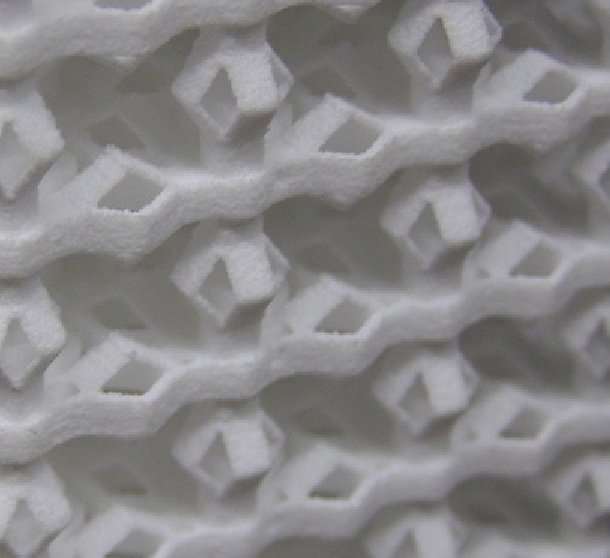Advance could enable novel high-performance materials

An engineering physics professor at the University of Wisconsin–Madison has created new materials that behave in an unusual way that defies the standard theory engineers use for designing things like buildings, airplanes, bridges and electronic devices.
It's an advance that could open the door to designing novel materials for applications that require high toughness—for example, airplane wings that are more fracture-resistant.
The classical elasticity theory works well for predicting the behavior of most ordinary materials, including steel, aluminum and concrete, and ensuring structures can withstand mechanical forces without breaking or deforming too much. But for some materials, the theory is limiting.
Roderic Lakes and graduate student Zachariah Rueger used 3-D printing to make their new polymer lattice materials. Their design—the pattern in which the materials' polymer strips are arranged—is a repeating crisscross structure. When it's twisted or bent, a bar of this polymer lattice is about 30 times stiffer than would be expected based on classical elasticity theory.
The Wisconsin researchers described their new lattice materials in the journal Physical Review Letters on Feb. 8, 2018.
Performing measurements in the lab, Lakes determined that the materials' behavior was consistent with Cosserat elasticity, a more descriptive theory of elasticity that takes into consideration the size of the underlying structure in a material.
"When you have a material with substructure in it, such as some foams, lattices and fiber-reinforced materials, there's more freedom in it than classical elasticity theory can handle," Lakes says. "So we're studying the freedom of materials to behave in ways not anticipated by the standard theory."
This increased freedom offers a potential path to creating novel materials that are immune to stress concentration; in other words, materials with improved toughness. Such materials would be useful for a variety of applications, including making airplane wings more resistant to cracks.
If a crack forms in an airplane wing, stress is concentrated around the crack, making the wing weaker. "You need a certain amount of stress to break something, but if there's a crack in it, you can break it with less stress," Lakes says.
Using the Cosserat theory of elasticity to inform materials design will yield tougher materials in which stresses are distributed throughout the materials differently, according to Lakes.
These same effects are present in materials such as bone and certain types of foams. However, when engineers make foam for a seat cushion, for example, they don't have much control over the foam's substructure—the tiny bubbles that form and make up the cells inside the foam. As a result, they have limited ability to tailor the Cosserat effects.
In contrast to foam, the UW–Madison researchers can tune the Cosserat effects in their lattice materials and make them very strong.
"We developed a material in which we have exceptionally detailed control over the fine structure of our lattice, and that enabled us to achieve very strong effects when bending and twisting the material," Lakes says.
Journal information: Physical Review Letters
Provided by University of Wisconsin-Madison





















